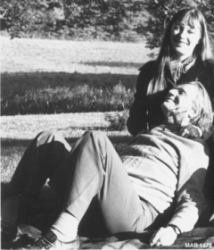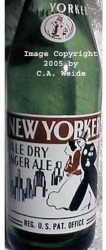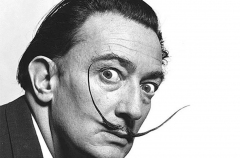Herman De Vries was born in Holland and due to his early training in woodworking, moved to the Dutch speaking and furniture making area of western Michigan around Grand Rapids. He worked for Stickley Brothers Company, Grand Rapids and left them in 1919 to set up a freelance design business. Before Stickley, De Vries worked for W.K. Cowen & Co and Marshall Field & Company and in the spring of 1936 for the H.T. Cushman Furniture Company he designed a “Modern Creations” line. In the 1930’s he designed for Sikes Furniture Company of Buffalo, New York.
Russel Wrigh
Russel Wright was born in 1904 in Lebanon, Ohio. Baptized Russell Wright, according to Russell Lynes, Wright ordered some stationary that arrived misprinted, “Russel”; Wright is quoted at explaining his name change, “That (spelling) seemed to be distinctive, so I adopted it”.
Norman Bel Geddes
Norman Bel Geddes was born in 1893 and named Norman Melancton Geddes. In 1916 he married Helen Belle Schneider and they incorporated her name, changing his to Norman Bel Geddes.
Bel Geddes started his career designing sets and scenes for New York operas and shows; he also designed for at least one movie.
In 1927 he opened an industrial design studio and applied his “Streamline” ideals to many household and consumer products. Two of his books, Horizons (1932) and Magic Motorways (1940) were successful and influential.
Eugene Schoen
Eugene Schoen (1880-1957) was born in New York City. He attended Columbia University, graduating in 1901 with a degree in architecture. The Paris Exposition of 1925 inspired him to open an interior decorating business specializing in the new Modern movement. He designed furniture, rugs, and occasional items for his clients. His work was exhibited at The Metropolitan Museum of Art’s two exhibits of industrial design.
Fritz Eldon Baldauf
Fritz Eldon Baldauf was born on December 8, 1887 in Annaberg, Germany. At sixteen he started studies at the Royal Art School in Dresden. In 1909 he completed his courses in architecture at the University of Munich. In 1911 he won an architect’s contest and became one of the first architects in Europe to design the interiors as well as exteriors of homes.
Eliel Saarinen
Eliel Saarinen et al.
In 1939 Eliel Saarinen (1873-1950), Eva Lisa (Pipsan) Saarinen Swanson (1905-1979), and J. Robert F. Swanson (1900-1981) introduced their “Flexible Home Arrangements Group” which consisted of 32 designs of furniture. The furniture was manufactured by The Johnson Furniture Company of Grand Rapids.
In 1947 Pipsan Saarinen Swanson and Robert Swanson introduced the “Saarinen-Swanson Group” which added 22 new designs to the group including updated designs, which Eliel Saarinen originally made for the Flexible Home Arrangements Group.
Charles Hardy
Little is known of Charles Hardy beyond the patent for this table (we present three variations). It is a grand example of American Art Deco furniture design.
Ralph Hewitt Widdicomb
Ralph Hewitt Widdicomb was born in Grand Rapids, Michigan in 1873, the same year The Widdicomb Furniture Company was incorporated. The son of Henry E. Widdicomb, he attended Grand Rapids public schools and went to work in 1898 for his uncle’s company as a furniture designer. After designing period revival pieces, he won first prize at the 1900 Paris Exposition for an American Empire bedroom suite. He turned in the early 1930’s to designing in the Modern manner. A cabinet he designed in the Modern style is in The Wolfsonian-FIU Museum, Miami Beach, Florida.
William J. Campbell
W.J. Campbell is known as the designer of this smoking stand. Two versions of the stand are presented here, both follow the patent drawing. We have seen other climax ash stands with various arrangements of the support pods, size of the drinks holder, and style of the ash receiver. Some have an emblem from a railroad as many were used on smoking cars. As far as we can tell this is Campbell’s only contribution to American Art Deco Furniture.
John Vassos
John Vassos (born John Vassacopoulos) was born in 1898 in Romania to Greek parents. He immigrated to the United States in 1919. In 1924 he opened a studio designing murals, advertisements, and window displays. In 1933 he designed a turnstile, still in use in subways and sports stadiums.
He illustrated fourteen books including four he coauthored with his wife. He designed radio cabinets for RCA Victor and early RCA television sets.




.png)